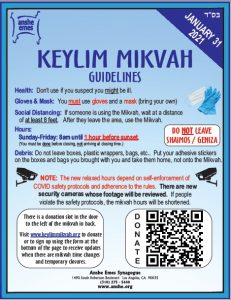PARSHA MASEI
I. Summary
A. The Jews’ Itinerary. Moshe recorded the Israelites’ itinerary from the Exodus until their arrival at the plains of Moav. In all, the Israelites had encamped in forty-two separate places during their forty years of wandering.
B. Division of land. After conquering Canaan, the Jews were told to destroy any remnant of idol worship in the country. Ten leaders (one from each of the tribes other than Reuven and Gad), plus Yehoshua and Elazar were appointed to administer the equitable division of the land (which was distributed by lots in proportion to each tribe’s size). The Levi’im, who were not given separate land, were granted forty-eight cities on both sides of the Jordan.
C. Cities of Refuge/Laws of Murder. Six of the Levite cities (i.e., three on each side of the Jordan) were designated as Orei Miklot (“Cities of Refuge”), in addition to the other forty-two minor Orei Miklot. The Orei Miklot provided asylum for an accidental murderer, allowing him to escape the vengeance of the victim’s relatives. (A murderer could flee to the Orei Miklot, where he’d come before a judicial tribunal. If he was ruled an intentional murderer, he was handed over to the victim’s relative and anyone who committed a pre-meditated murder was put to death. If, however, the murder was unplanned and without evil intent, he could stay in the Orei Miklot until the High Priest’s death, at which time he was free to go home.) Even a willful murderer couldn’t be condemned to death unless two witnesses incriminated him. The willful murderer couldn’t commute his death sentence nor could the accidental murder escape the Orei Miklot by monetary payments.
D. Inheritance Rights. Leaders from the family of Gilad (from the tribe of Menasseh) raised the problem of land inherited by daughters, such as the Zelophchad’s daughters — i.e., if they married into another tribe, the property rights would go to the other tribe, reducing her former tribe’s holdings. This was solved by the ruling that during that generation only, an heiress should marry within her own tribe (which was, in fact, the case of Zelophchad’s daughters, who married their own cousins).
II. Divrei Torah
A. Lil’Mode U’lilamed (Rabbi Mordechai Katz)
1. Road signs. Chazal tell us that signs with directions to the Orei Miklot appeared on every cross-road in settled territories, whereas there were no signs directing one to Jerusalem (i.e., to where Jews traveled for the Festivals). Why? If the accidental murderer on route to the Orei Miklot was forced to ask directions, it would lead to gossip and make him a “marked man”. On the other hand, if Jews journeying to Jerusalem asked for directions, it would lead to discussion of the Festivals and perhaps their uniting for the journey. Thus, the Torah encourages public discussion of mitzvos and good deeds, while discouraging potentially harmful gossip.
2. Enumerating the Stages. No detail in the Torah is superfluous. Why then does the Torah list in such detail all of the various stages and stops in the Jews’ journey? Now that the Jews were to enter Israel, Hashem reminded them of their difficult journey, and that each stop along the way held its own unique memories and lessons for them to remember. The people had come a long way and shouldn’t forget Hashem’s assistance and the experiences that helped forge their national development.
B. Kol Dodi on the Torah (Rabbi David Feinstein)
1. The Road Away From Egypt. The Torah speaks of the “road away” from Egypt, rather than the road “to Israel”. This suggests that the Torah views the Exodus as more than just a physical or geographical re-location — it was (and, by analogy, is for us today) a spiritual process, involving the weaning of the “slave mentality” and the instilling of a commitment to Torah and Hashem.
2. “And these cites [Orei Miklot] shall be a refuge for you”. To whom does the Torah refer with the words “for you”? At first glance, it appears to refer to the Beis Din (religious courts) who were responsible for enforcing the Torah; yet, the Beis Din surely wasn’t composed of killers. As Pirke Avos teaches, bloodshed leads to exile of the Jews from their land. If the Beis Din didn’t take adequate steps to protect accidental killers from the vengeance of their victim’s relatives, innocent blood would be spilled, ultimately leading to exile. Additionally, the Beis Din must show everyone the value of human life. Rabbi Nathan Cardozo notes that the “you” refers to all of us — we are all responsible for the loss of human life; we must all be careful to prevent accidents; we must all work to ensure that there is not a cheapening of the value of human life.
C. Growth Through Torah (Rabbi Zelig Pliskin)
Awareness of others’ suffering is a partial consolation. Rambam explains why the High Priest’s death brought about the release of an accidental murderer from the Orei Miklot. One who is suffering is often relieved to learn that others have also suffered. The death of the High Priest was felt strongly by the entire Jewish people and was thus a partial consolation to the victim’s relatives, reducing their passion for revenge. This is relevant to us when we suffer — if we open our eyes to other’s suffering, we gain a more realistic perspective on our suffering, no longer feel “singled out” and are better able to cope with our plight.
D. Living Each Week (Rabbi Abraham Twerski)
1. Spirituality: A Gradual Process. In describing the journeys of the Israelites during their forty years in the desert, the Torah not only enumerates the various resting places, but at each point states, “They traveled from A and camped at B. They traveled from B and camped at C, etc.” Since the Torah doesn’t even have a single superfluous letter, why doesn’t it simply state, “They camped at A, B, C, etc.”? The Torah commentaries state that the forty years in the desert were a period of spiritual growth and development necessary to prepare the Jews for entrance into the holy land of Israel. The people that were capable of the lack of faith and trust in G-d manifested by the Golden Calf and the episode of the spies required a lengthy course in spiritual development, which they received under the tutelage of Moshe. Each encampment symbolizes another step in this process of spiritual development. While achieving spirituality is essential, it must proceed gradually. Only after the Jews had solidified their spiritual growth at a particular encampment were they able to travel to the next point, and if they regressed in their spiritual development, they had to go back and recoup the spirituality they had lost before they were able to progress further.
2. Maintaining a positive attitude. “They traveled from Marah and came to Elim, and in Elim there were twelves springs of water and seventy palms, and they camped there.” Inasmuch as the Torah does not describe any of the other camping sites, why does the Torah find it important to describe the features of Elim? In his commentary on the Parsha of Beshalach (supra), the Baal Shem Tov noted that the Israelites were unable to drink the water in Marah because they, the Israelites, were bitter. It is a common that when a person is in a state of depression and has an attitude of bitterness, everything appears to be bitter, regardless of how sweet it may be in reality. We must realize that our perception can be grossly distorted by our mood. The Torah teaches us this in the episode of Hagar and Ishmael, in which Hagar abandoned Ishmael in the desert, stating that she could not bear to see him die of thirst. “G-d opened her eyes and she saw a well of water.” The Torah is telling us that the well was there the whole time, but in her state of depression she didn’t see it. In Elim there were springs of water and seventy palms. Of what value is seventy palms to a population of several million? Having rid themselves of their dejection at Marah, coming upon a small oasis was a pleasant event. When they “traveled from Marah,” (i.e., when they separated themselves from their bitterness), then camping at Elim was a great event. Some of life’s events may cause us to become dejected. We must try to overcome this mood, and develop a positive attitude, because in a state of dejection, we may perceive reality in a negative light, whereas in a state of simchah (joy), we can recognize everything we have as a precious gift.
E. Chassidic Dimension/In the Garden of the Torah (the Lubavitcher Rebbe, Rabbi Menachem M. Schneerson, z’tl)
The “encampments” of the Jews. While the Torah refers to the “journeys” of the Jews, it is actually referring to where they encamped (in fact, the Jews spend the majority of the forty years in encampments, not in travel). Why? The ultimate purpose of travels and encampments was to reach Israel — the encampments are referred to as “journeys” since they served no purpose in and of themselves. The Bal Shem Tov noted that the “encampments” refer to the various stages of spiritual growth to be experienced during life’s journey. Each step of the journey represents in and of itself a phase of holiness and possesses an importance of its own. However, in order for one to attain the next spiritual level, he must be “on the move” — if he stagnates or merely moves to a comparable level, he is considered stationary. “On the move” means that he has totally departed from his previous level. Thus, the verse emphasizes “journey” to remind us that we must always be on the “upward move,” constantly striving to reach an infinitely higher spiritual level than our current level. The forty-two “journeys” of the Jews allowed them to reach the proper spiritual level to enter Israel.
F. Majesty of Man (Rabbi A. Henach Leibowitz)
Remembering the painful moments of our journeys. Rashi quotes a Midrash that explains, via parable, why Hashem chose to recount the Israelite’s travels: A king once took his ill son abroad to find a cure; during their journey home (after the boy had been cured), he recounted the stops along the way — “here you had a fever . . . “, etc. Similarly, Hashem recounted all of the places where the Jews had angered Him on the way to Israel. However, unlike the king who recounted the stops to evoke feelings of relief and thankfulness, Hashem’s actions are harder to fathom for they don’t seem to conjure feelings of relief and thankfulness. But, Hashem has infinite love for the Jewish people; even when we sin and act with ingratitude towards Him, He doesn’t view it in that light — in His eyes, these are merely temporary illnesses. Hashem’s love and compassion for the Jewish people is particularly uplifting during the Three Weeks preceding the 9th of Av, reminding us that our teshuvah (repentance) doesn’t fall on “deaf ears”.
H. Parsha Parables (Rabbi Mordechai Kamenetsky)
Kinder, gentler killers. In this Parsha, we learn about the Orei Miklot (Cities of Refuge). In addition to killers, the Levites lived in these cities; there the Levites played an integral role in the killers’ rehabilitation. The sentence imposed on the killers was also unique, since it was defined by circumstance (i.e., it lasted until the Kohein Gadol’s death), not time. Thus, the Midrash says, the Kohein Gadol’s family were worried that the convicts would pray for the Kohein Gadol’s early death; thus, in order to dissuade them, the Kohein Gadol’s mother would distribute food and clothing to the convicts. It is hard to understand. Didn’t the convicts have loved ones waiting for him/her with food and clothing? Was the Kohein Gadol’s mother’s food worth exile in the City of Refuge? Rabbi Aryeh Levine took it upon himself to visit Jewish inmates. Becoming like a father to these prisoners, he brought them food, clothes and love. For years, despite terrible weather conditions, he never missed a lengthy Shabbos visit. Once, in the midst of a Shabbos service, he was called out of the prison by a very excited messenger. Reb Aryeh’s daughter had become paralyzed, and the doctors were helpless. He was need for support at home — immediately. After Shabbos, a messenger was sent by the concerned inmates to inquire what tragedy had interrupted the Rabbi’s weekly visit. The next Shabbos, despite the enduring tragedy at home, Reb Aryeh went to the prison as usual. Normally, during the Torah reading, prisoners pledged a few coins to charity. That week the donations were far different. “I will give up a week of my life for the sake of Reb Aryeh’s daughter,” the first convict pledged. Another prisoner pledged a month of his life. Each one called to the Torah upped the previous pledge until the last prisoner cried out, “what is our life compared to Reb Aryeh’s anguish? I will give all my remaining days for the sake of the Rabbi’s daughter.” At this remarkable display of love and affection, Reb Aryeh broke down and wept. Miraculous as it may sound, that Saturday night Reb Aryeh’s daughter began to move; within days she had fully recovered. The Orei Miklot were not jails or detention camps. They were an environment in which reckless people became aware of the serious ramifications of their careless actions. Constantly under the influence of the Levites, the prisoners would observe them pray, learn and teach, and see the epitome of awareness and care for fellow human beings. The mission of the Kohein Gadol’s mother was not merely to distribute food; its true purpose was to develop a bond with those people whose carelessness spurred death. They saw the love a mother had for her son, and how a total stranger would make certain that their needs were met. The Torah cannot punish without teaching and rehabilitating. As it infuses a love for live and spirituality into former careless killers, its goal is to mold a new person whose attitude will cause him to be kinder, gentler and more careful.



 Visit the group and request to join.
Visit the group and request to join.
